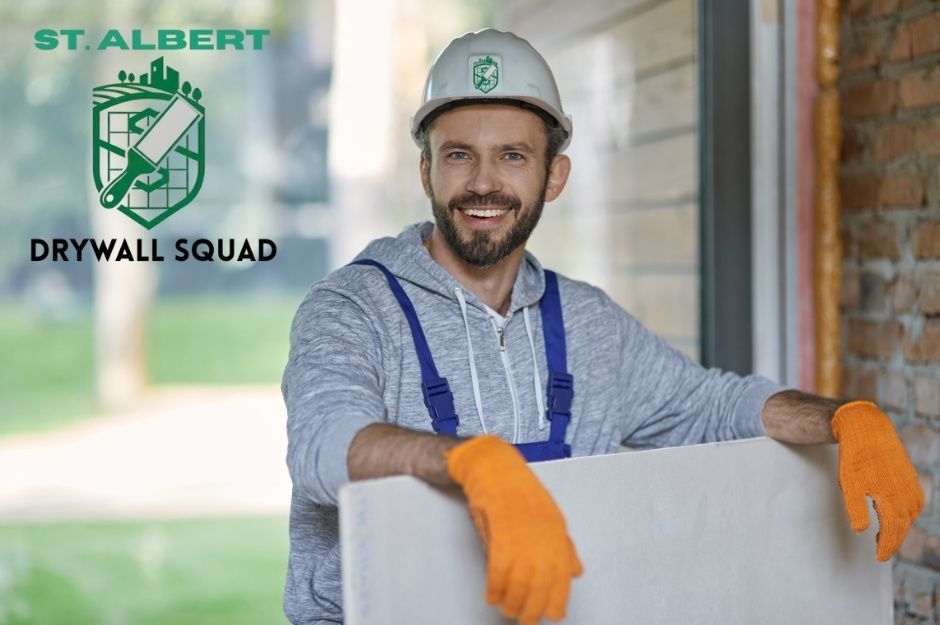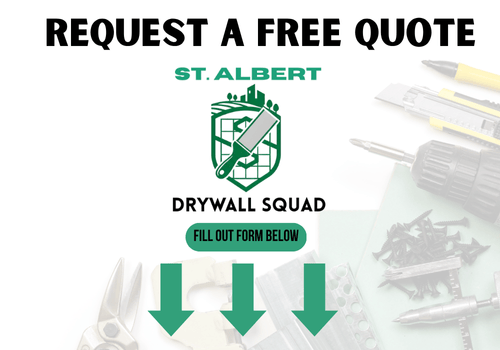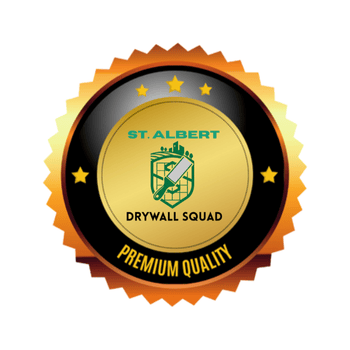Nisku Drywall Repair
Expert Drywall Repair Company in Nisku, Alberta

Drywall damage can transform even the most beautiful home into an eyesore. Professional drywall repair contractors at St. Albert Drywall Squad in Nisku, Alberta offer comprehensive solutions for patching holes, fixing cracks, removing popcorn ceilings, repairing water damage, and handling complete installation and finishing projects.

St. Albert Drywall Squad (CP)

Your drywall needs extend beyond simple patching work. These modern contractors provide specialized services including textured ceiling repairs, seamless hole patching, and precision finishing that match your existing wall surfaces perfectly.
Serving the Nisku Industrial Park area—one of Western Canada's largest business parks spanning 2,044 hectares with over 400 businesses—local contractors understand the unique demands of both commercial and residential properties in this hamlet located at 705 metres elevation.
Finding the right contractor requires understanding the full scope of available services and knowing what questions to ask before hiring. The best drywall professionals combine technical expertise with quality materials to deliver lasting results that restore your home's appearance and value.
Drywall Repair Services in Nisku, Alberta
Professional drywall repair addresses common issues like holes, cracks, nail pops, and water damage through specialized techniques and materials. Skilled contractors in Nisku provide comprehensive solutions for both minor patches and extensive moisture-related repairs. Given Nisku's location in Leduc County (census division No. 11) and its proximity to both Edmonton and Leduc, contractors here serve a diverse client base including the 6,000+ workers employed in the industrial park.
Common Types of Drywall Damage
Your drywall faces various forms of damage throughout its lifespan. Physical impact creates holes from doorknobs, furniture, or accidental contact with walls.
Settlement cracks appear along joints and corners as your home's foundation shifts naturally over time. These hairline fractures typically run vertically or diagonally across wall surfaces. In Nisku's industrial facilities and warehouse spaces, settlement cracks are particularly common due to the heavy equipment and constant vehicle traffic serving businesses in the park.
Nail pops occur when fasteners work loose from temperature changes and house movement. You'll notice small circular bumps or cracks around screw and nail locations. Alberta's extreme temperature fluctuations—particularly in the Edmonton Metropolitan Region where Nisku is located—can accelerate nail pop issues in both residential and commercial structures.
Water damage presents the most serious concern for drywall integrity. Leaks, flooding, or high humidity cause discoloration, soft spots, and potential mold growth.
Textural issues include damaged popcorn ceilings or worn finish coats that affect your wall's appearance and protective qualities.
Patch and Hole Repair
Small holes under 2 inches require mesh patches or self-adhesive repair kits that you can apply directly over the damaged area. The contractor applies joint compound in thin layers and sands smooth.
Medium holes between 2-6 inches need drywall patches cut to fit the opening. Professional repair involves securing backing material behind the hole and installing a precisely measured patch piece.
Large holes over 6 inches require complete section replacement. Your contractor cuts out the damaged area to the nearest wall studs and installs new drywall secured to the framing.
Texture matching ensures seamless repairs that blend with existing wall surfaces. Contractors recreate orange peel, knockdown, or smooth finishes to match surrounding areas perfectly.
Cracking and Nail Pop Repair
Hairline cracks receive treatment with mesh tape and multiple joint compound applications. Your contractor applies thin coats, allowing complete drying between layers.
Larger cracks require cutting out loose material and installing new tape along the entire length. This prevents recurring separation at the same location.
Nail pop repair involves driving fasteners below the surface and applying joint compound over the depression. Contractors often add additional screws nearby for improved holding power.
Corner cracks need special attention with metal or paper corner bead replacement. The repair process includes removing damaged bead and installing new corner protection before finishing.
Water and Moisture Damage Repair
Immediate assessment determines the extent of water penetration and potential mold growth. Your contractor checks insulation, framing, and electrical components behind affected drywall.
Complete removal of water-damaged sections prevents ongoing moisture problems and health concerns. Contractors cut out affected areas extending 12 inches beyond visible damage.
Moisture source elimination must occur before repair work begins. This includes fixing leaks, improving ventilation, or addressing humidity issues that caused the original damage. In Nisku's industrial facilities located near the Edmonton International Airport and along Highway 625 (20 Avenue), moisture issues often stem from HVAC systems in large warehouse spaces or roof drainage problems common in commercial structures.
Antimicrobial treatment of exposed framing and surrounding areas prevents future mold growth. New drywall installation includes proper vapor barriers and ventilation considerations.
Ceiling Solutions and Texture Services
Professional ceiling contractors in Nisku handle popcorn removal, structural repairs, and precise texture restoration to address both aesthetic and functional ceiling issues. Since the Nisku Industrial Park was established in 1972 by the Sparrow family (brothers Bert, Jim, Murrey, and Don Sparrow), many older commercial buildings in the area contain original ceiling finishes that require specialized restoration techniques.
Popcorn Ceiling Removal
Popcorn ceiling removal requires specialized techniques to safely eliminate textured surfaces without damaging underlying drywall. Professional contractors use proper containment methods to prevent debris from spreading throughout your home.
The removal process begins with moisture application to soften the texture material. Contractors then scrape away the popcorn using wide putty knives and specialized tools.
Safety considerations include:
- Asbestos testing for ceilings installed before 1980 (particularly important for structures built in Nisku's early development years following 1972)
- Dust containment systems
- Proper ventilation during removal
After removal, contractors smooth and prepare the surface for new finishes. This typically involves applying joint compound to fill imperfections and sanding to achieve a uniform base.
Most popcorn removal projects take 2-3 days depending on room size and ceiling condition.
Ceiling Drywall Repair
Water damage represents the most common ceiling repair issue in Nisku homes. Contractors address staining, sagging, and structural damage caused by roof leaks or plumbing failures.
Common ceiling repairs include:
- Crack filling and reinforcement
- Water stain treatment and sealing
- Sagging drywall replacement
- Hole patching from fixtures or impacts
Repair work starts with identifying and addressing the moisture source. Contractors then remove damaged sections and install new drywall pieces cut to fit precisely.
Joint compound application follows in multiple coats. Each layer requires proper drying time before sanding and applying the next coat.
Structural repairs may require additional framing support before drywall installation.
Texture Matching Techniques
Texture matching ensures repaired areas blend seamlessly with existing ceiling finishes. Skilled contractors analyze existing patterns and replicate them using appropriate tools and techniques.
Common texture types include:
- Knockdown texture
- Orange peel finish
- Smooth flat finishes
- Custom decorative patterns
Contractors use spray equipment, rollers, or hand tools depending on the desired texture pattern. Practice applications on sample boards help achieve accurate matches before working on visible areas.
Lighting conditions affect texture appearance, so contractors evaluate matches under different lighting scenarios. Multiple thin applications typically produce better results than single heavy coats.
Color matching follows texture work to complete the seamless repair appearance.
Expert Drywall Installation and Finishing
Professional drywall installation requires precise measurement, proper attachment, and systematic finishing techniques. The process involves securing panels, applying multiple compound coats, and preparing surfaces for final paint application. Contractors serving the Nisku area—located east of the Queen Elizabeth II Highway (Highway 2) intersection with Highway 625—bring expertise in both residential homes and the commercial spaces that dominate this business park described as "as large as all of downtown Toronto from the waterfront to Forest Hill."
Drywall Installation Process
Contractors begin by measuring your space and cutting drywall panels to exact specifications. Standard 4x8 or 4x12 sheets are positioned vertically or horizontally depending on room height and structural requirements.
Professional installers secure panels using drywall screws spaced 16 inches apart along studs. They ensure screws sit slightly below the surface without breaking the paper face. Joints between panels require careful alignment to minimize gaps.
Key Installation Steps:
- Measure and cut panels precisely
- Position sheets against framing members
- Drive screws into studs at proper intervals
- Check for level alignment and secure attachment
Your contractor will install ceiling panels first, followed by wall sections. This sequence provides better joint support and reduces potential cracking.
Professional Drywall Finishing
Drywall finishing involves applying joint compound in three separate coats over seams and screw holes. Each coat requires complete drying before the next application.
The first coat embeds paper tape into compound along all joints. Contractors apply compound with a 6-inch knife, pressing tape firmly to eliminate air bubbles.
Second coats use 8-10 inch knives to feather edges beyond the first application. This creates smoother transitions between treated and untreated surfaces.
Finishing Coat Sequence:
- First coat: Tape embedding with 6-inch knife
- Second coat: Edge feathering with 8-10 inch knife
- Final coat: Surface smoothing with 12-inch knife
Final coats require 12-inch knives for broad, smooth coverage. Professional drywall repair techniques ensure seamless integration with existing surfaces.
Spackle and Surface Priming
After compound cures completely, contractors sand surfaces using fine-grit paper or sanding screens. This removes ridges and creates uniform texture for paint adhesion.
Spackle application fills any remaining imperfections smaller than nail holes. Your contractor applies thin layers with putty knives, avoiding excess material that requires additional sanding.
Priming prepares finished drywall for paint by sealing porous compound and paper surfaces. Contractors use high-quality drywall primers that prevent paint absorption differences between compound and paper areas.
Surface preparation includes dust removal using tack cloths or vacuum systems. Clean surfaces ensure proper primer adhesion and professional paint results.
Choosing a Drywall Contractor in Nisku
Finding the right drywall contractor requires careful evaluation of their professional credentials, understanding service pricing, and ensuring proper warranty protection for your investment. In Nisku—a hamlet whose Cree name means "goose"—you'll find contractors experienced with both the residential properties within the hamlet (located north of Highway 625 between Sparrow Drive and the Canadian Pacific Kansas City railway) and the diverse commercial facilities throughout the industrial park.
Evaluating Professional Qualifications
Check each contractor's licensing status and insurance coverage before making your decision. Alberta contractors should carry both liability insurance and workers' compensation coverage.
Request references from recent projects similar to yours. Professional drywall repair specialists will readily provide contact information for past clients. Call these references to ask about work quality and completion timelines.
Review online ratings on multiple platforms including Better Business Bureau, TrustedPros, and local review sites. Look for contractors with consistent positive feedback across different platforms. Given that Leduc County does not levy a business tax in the Nisku Industrial Park, many contractors maintain local offices here, making it easier to verify their physical presence and reputation within the community.
Verify the contractor's experience with your specific repair needs. Some specialize in patch boys style quick fixes while others handle complex water damage restoration or popcorn ceiling removal.
Ask about their team's training and certifications. Experienced contractors invest in ongoing education about new materials and techniques.
Schedule consultations with at least three contractors. During these meetings, assess their professionalism, punctuality, and communication skills.
Understanding Drywall Repair Costs
Drywall repair cost varies significantly based on damage extent and repair complexity. Small patches typically cost $75-150 per hole. Larger repairs or ceiling work range from $200-600 per section.
Water damage repairs cost more due to potential mold remediation and structural issues. Expect to pay $300-800 for water-damaged sections requiring replacement.
Texture matching adds $50-100 to most repair jobs. Popcorn ceiling removal costs $1-3 per square foot depending on asbestos testing requirements.
Request detailed written estimates from each contractor. Compare line items rather than just total costs to understand value differences.
Be cautious of estimates significantly below market rates. These often indicate corners will be cut on materials or preparation work.
Factor in potential additional costs like primer, paint, or minor electrical work that may be discovered during repairs. Contractors serving the Edmonton—Wetaskiwin federal riding, which includes Nisku, often provide competitive pricing due to the high volume of commercial work available in the area's 400+ businesses.
Warranty and Satisfaction Guarantees
Quality contractors offer written warranties on both materials and workmanship. Standard warranties cover defects for 1-2 years after completion.
Drywall repair services should guarantee their work against cracking, peeling, or texture mismatches. Ensure warranty terms are clearly defined in your contract.
Ask about their policy for addressing issues that arise after project completion. Reputable contractors return promptly to fix legitimate warranty claims.
Understand what voids the warranty. Typical exclusions include damage from settling, moisture infiltration, or homeowner alterations.
Request warranty documentation before final payment. Keep these documents with your home improvement records for future reference.
Some contractors offer satisfaction guarantees beyond standard warranties. These policies demonstrate confidence in their workmanship and commitment to customer service.